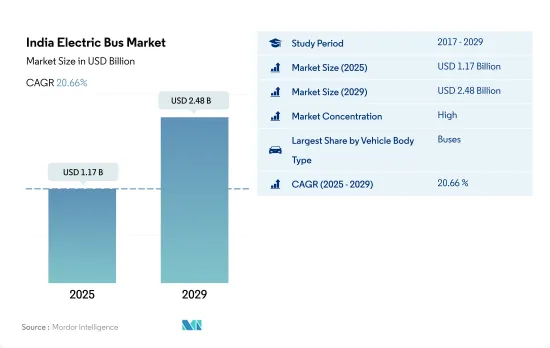 |
市場調查報告書
商品編碼
1693622
印度電動公車:市場佔有率分析、產業趨勢與統計、成長預測(2025-2030 年)India Electric Bus - Market Share Analysis, Industry Trends & Statistics, Growth Forecasts (2025 - 2030) |
||||||
※ 本網頁內容可能與最新版本有所差異。詳細情況請與我們聯繫。
印度電動公車市場規模預計在 2025 年達到 11.7 億美元,預計到 2029 年將達到 24.8 億美元,預測期(2025-2029 年)的複合年成長率為 20.66%。

印度電動公車市場趨勢
政府措施和嚴格規範推動印度電動車市場快速成長
- 印度的電動車 (EV) 市場正處於成長階段,政府正在積極制定應對污染的策略。 2015年啟動的Fame India計畫在推動汽車電氣化方面發揮了關鍵作用。基於其成功經驗,Fame 第二階段計劃將持續到 2022 年 4 月,這將進一步促進電動車的銷量,尤其是在 2021 年,政府將為電池容量高達 15kWh 的電動車提供 10,000 印度盧比(約 1,000 萬美元)的補貼。
- 印度各邦政府正大力引進電動公車,以擺脫內燃機(ICE)公車的束縛。此舉不僅可以降低營運成本,還可以抑制碳排放並改善空氣品質。引人注目的是,德里政府已於 2021 年 3 月批准採購 300 輛新型低地板電動(AC)公車,其中 100 輛將於 2022 年 1 月上路。這些舉措導致印度對電動商用車的需求大幅成長,2022 年與 2021 年相比成長了 62.58%。
- 受政府嚴格標準的推動,近年來電動車的需求激增。 2021年8月,印度政府宣布了一項車輛報廢政策,旨在逐步淘汰污染嚴重且不合規的車輛,無論其使用年限為何。該政策將於 2024 年實施,旨在推動消費者購買電動車。此外,政府還設定了一個雄心勃勃的目標,即到 2030 年使印度 30% 的汽車實現電動化。這些舉措預計將在 2024 年至 2030 年期間促進印度的電動車銷售。
印度電動巴士產業概況
印度電動公車市場相當集中,前五名廠商佔79.05%的市場。市場的主要企業有:JBM Auto Limited、Olectra Greentech Ltd.、PMI Electro Mobility Solutions Pvt。 Ltd.、Switch Mobility(Ashok Leyland Limited)和Tata Motors Limited(按字母順序)
其他福利
- Excel 格式的市場預測 (ME) 表
- 3個月的分析師支持
目錄
第1章執行摘要和主要發現
第2章 報告要約
第3章 引言
- 研究假設和市場定義
- 研究範圍
- 調查方法
第4章 產業主要趨勢
- 人口
- 人均GDP
- 消費者汽車支出(cvp)
- 通貨膨脹率
- 汽車貸款利率
- 共乘
- 電氣化的影響
- 電動車充電站
- 電池組價格
- 新款 Xev 車型發布
- 燃油價格
- OEM生產統計
- 法律規範
- 價值鍊和通路分析
第5章市場區隔
- 燃料類別
- BEV
- FCEV
- HEV
- PHEV
第6章競爭格局
- 重大策略舉措
- 市場佔有率分析
- 商業狀況
- 公司簡介
- Eicher Motors Ltd.
- JBM Auto Limited
- Olectra Greentech Ltd.
- PMI Electro Mobility Solutions Pvt. Ltd.
- Solaris Bus & Coach SA
- Switch Mobility(Ashok Leyland Limited)
- Tata Motors Limited
- VE Commercial Vehicles Limited
- Volvo Buses India Private Limited
第7章:CEO面臨的關鍵策略問題
第 8 章 附錄
- 世界概況
- 概述
- 五力分析框架
- 全球價值鏈分析
- 市場動態(DRO)
- 資訊來源及延伸閱讀
- 圖片列表
- 關鍵見解
- 數據包
- 詞彙表
The India Electric Bus Market size is estimated at 1.17 billion USD in 2025, and is expected to reach 2.48 billion USD by 2029, growing at a CAGR of 20.66% during the forecast period (2025-2029).

India Electric Bus Market Trends
Government initiatives and stringent norms drive rapid growth in the electric vehicle market in India
- India's electric vehicle (EV) market is in a growth phase, with the government actively formulating strategies to combat pollution. The Fame India scheme, launched in 2015, has played a pivotal role in driving vehicle electrification. Building on its success, Fame Phase 2, active till April 2022, further bolstered EV sales, especially in 2021, with the government offering subsidies like INR 10,000 grants for electric cars with battery capacities up to 15 kWh.
- State governments across India are increasingly incorporating electric buses into their fleets, aiming to transition from internal combustion engine (ICE) buses. This move not only cuts operational costs but also curbs carbon emissions and improves air quality. In a notable move, the Delhi government greenlit the procurement of 300 new low-floor electric (AC) buses in March 2021, with 100 of them hitting the roads in January 2022. These initiatives contributed to a significant 62.58% surge in demand for electric commercial vehicles in India in 2022 over 2021.
- The demand for electric cars has surged in recent times, driven by the government's introduction of stringent norms. In August 2021, the Indian government unveiled the Vehicle Scrappage Policy, targeting the phasing out of polluting and unfit vehicles, irrespective of their age. This policy, set to be implemented by 2024, is steering consumers toward electric cars. Additionally, the government has set an ambitious target of having 30% of all cars in India electrified by 2030. These initiatives are poised to propel electric car sales during the 2024-2030 period in India.
India Electric Bus Industry Overview
The India Electric Bus Market is fairly consolidated, with the top five companies occupying 79.05%. The major players in this market are JBM Auto Limited, Olectra Greentech Ltd., PMI Electro Mobility Solutions Pvt. Ltd., Switch Mobility (Ashok Leyland Limited) and Tata Motors Limited (sorted alphabetically).
Additional Benefits:
- The market estimate (ME) sheet in Excel format
- 3 months of analyst support
TABLE OF CONTENTS
1 EXECUTIVE SUMMARY & KEY FINDINGS
2 REPORT OFFERS
3 INTRODUCTION
- 3.1 Study Assumptions & Market Definition
- 3.2 Scope of the Study
- 3.3 Research Methodology
4 KEY INDUSTRY TRENDS
- 4.1 Population
- 4.2 GDP Per Capita
- 4.3 Consumer Spending For Vehicle Purchase (cvp)
- 4.4 Inflation
- 4.5 Interest Rate For Auto Loans
- 4.6 Shared Rides
- 4.7 Impact Of Electrification
- 4.8 EV Charging Station
- 4.9 Battery Pack Price
- 4.10 New Xev Models Announced
- 4.11 Fuel Price
- 4.12 Oem-wise Production Statistics
- 4.13 Regulatory Framework
- 4.14 Value Chain & Distribution Channel Analysis
5 MARKET SEGMENTATION (includes market size in Value in USD and Volume, Forecasts up to 2029 and analysis of growth prospects)
- 5.1 Fuel Category
- 5.1.1 BEV
- 5.1.2 FCEV
- 5.1.3 HEV
- 5.1.4 PHEV
6 COMPETITIVE LANDSCAPE
- 6.1 Key Strategic Moves
- 6.2 Market Share Analysis
- 6.3 Company Landscape
- 6.4 Company Profiles
- 6.4.1 Eicher Motors Ltd.
- 6.4.2 JBM Auto Limited
- 6.4.3 Olectra Greentech Ltd.
- 6.4.4 PMI Electro Mobility Solutions Pvt. Ltd.
- 6.4.5 Solaris Bus & Coach S.A.
- 6.4.6 Switch Mobility (Ashok Leyland Limited)
- 6.4.7 Tata Motors Limited
- 6.4.8 VE Commercial Vehicles Limited
- 6.4.9 Volvo Buses India Private Limited
7 KEY STRATEGIC QUESTIONS FOR VEHICLES CEOS
8 APPENDIX
- 8.1 Global Overview
- 8.1.1 Overview
- 8.1.2 Porter's Five Forces Framework
- 8.1.3 Global Value Chain Analysis
- 8.1.4 Market Dynamics (DROs)
- 8.2 Sources & References
- 8.3 List of Tables & Figures
- 8.4 Primary Insights
- 8.5 Data Pack
- 8.6 Glossary of Terms










